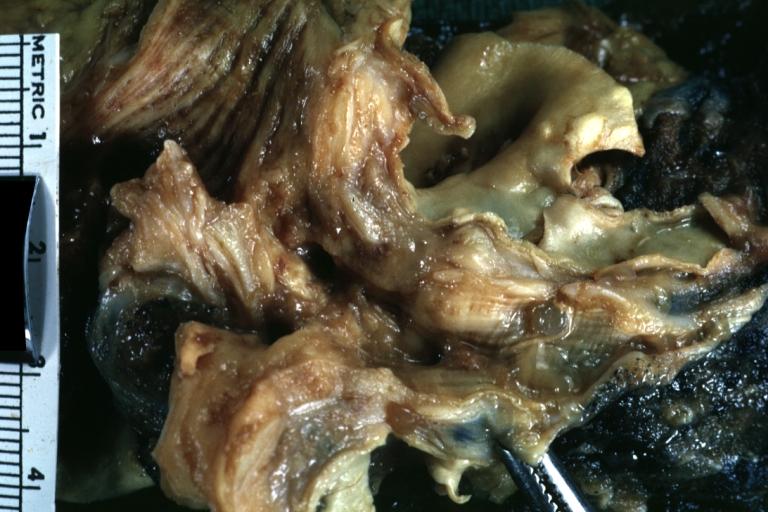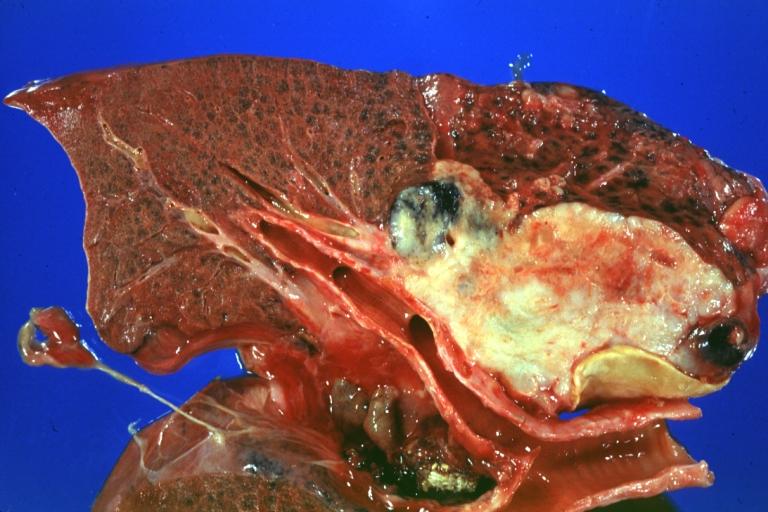Small cell carcinoma of the lung pathophysiology: Difference between revisions
| Line 26: | Line 26: | ||
==Gross Pathology== | ==Gross Pathology== | ||
* The tumor cells are small and round, but sometimes can be ovoid or spindle shaped. They have a scant cytoplasm with a high mitotic count and a hyperchromatic nuclei. | * The tumor cells are small and round, but sometimes can be ovoid or spindle shaped. They have a scant [[cytoplasm]] with a high mitotic count and a hyperchromatic [[nuclei]]. Nearly all SCLC are immunoreactive for [[keratin]], [[thyroid transcription factor 1]], and epithelial membrane antigen. Neuroendocrine and neural differentiation result in the expression of dopa decarboxylase, calcitonin, neuron-specific enolase, chromogranin A, CD56 (also known as nucleosomal histone kinase 1 or neural-cell adhesion molecule), gastrin-releasing peptide, and insulin-like growth factor 1. One or more markers of neuroendocrine differentiation can be found in approximately 75% of SCLC | ||
[http://www.peir.net Images courtesy of Professor Peter Anderson DVM PhD and published with permission © PEIR, University of Alabama at Birmingham, Department of Pathology] | [http://www.peir.net Images courtesy of Professor Peter Anderson DVM PhD and published with permission © PEIR, University of Alabama at Birmingham, Department of Pathology] | ||
Revision as of 19:04, 9 June 2014
|
Small Cell Carcinoma of the Lung Microchapters |
|
Differentiating Small Cell Carcinoma of the Lung from other Diseases |
|---|
|
Diagnosis |
|
Treatment |
|
Case Studies |
|
Small cell carcinoma of the lung pathophysiology On the Web |
|
American Roentgen Ray Society Images of Small cell carcinoma of the lung pathophysiology |
|
Small cell carcinoma of the lung pathophysiology in the news |
|
Directions to Hospitals Treating Small cell carcinoma of the lung |
|
Risk calculators and risk factors for Small cell carcinoma of the lung pathophysiology |
Editor-In-Chief: C. Michael Gibson, M.S., M.D. [1]
Overview
Small cell lung cancer is the most aggressive form of lung cancer. It usually starts in the breathing tubes (bronchi) in the center of the chest. Although the cancer cells are small, they grow very quickly and create large tumors. These tumors often spread rapidly (metastasize) to other parts of the body, including the brain, liver, and bone.
Molecular Abnormalities
A mutation in p53 is found in 75% to 100% of cases of small cell carcinoma. Other molecular abnormalities have been described that influence in the development of small cell carcinoma, such as chromosome 3p deletion, MYC amplification, BCL2 expression, GRP (gastrin-releasing peptide) expression , RB1 deletion (loss of RB1 protein), VEGF (vascular endothelial growth factor) expression, c-kit/SCFR (stem cell factor receptor) coexpression.[1]
Smoking
Paraneoplastic Syndrome
- Small cell carcinoma is one of the most common tumors associated to a paraneoplastic syndrome. The most common endocrine condition is SIADH, where there is an excessive secretion of ADH which leads to hyponatremia. Other conditions that are related to small cell carcinoma are the secretion of ANP, where the patient has hyponatremia, natriuresis and hypotension; ectopic ACTH production, which causes Cushing syndrome; and Lambert-Eaton syndrome, where there are antibodies that are directed against the antigens of the neuromuscular junction.
Gross Pathology
- The tumor cells are small and round, but sometimes can be ovoid or spindle shaped. They have a scant cytoplasm with a high mitotic count and a hyperchromatic nuclei. Nearly all SCLC are immunoreactive for keratin, thyroid transcription factor 1, and epithelial membrane antigen. Neuroendocrine and neural differentiation result in the expression of dopa decarboxylase, calcitonin, neuron-specific enolase, chromogranin A, CD56 (also known as nucleosomal histone kinase 1 or neural-cell adhesion molecule), gastrin-releasing peptide, and insulin-like growth factor 1. One or more markers of neuroendocrine differentiation can be found in approximately 75% of SCLC
References
- ↑ Grace K. Dy & Alex A. Adjei (2002). "Novel targets for lung cancer therapy: part I". Journal of clinical oncology : official journal of the American Society of Clinical Oncology. 20 (12): 2881–2894. PMID 12065566. Unknown parameter
|month=ignored (help)

